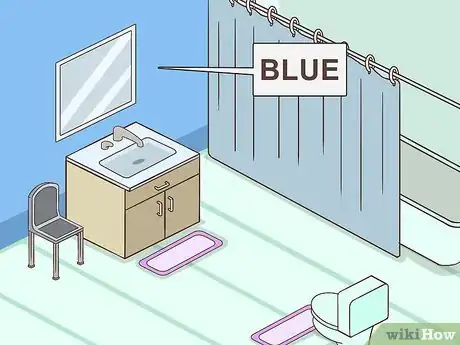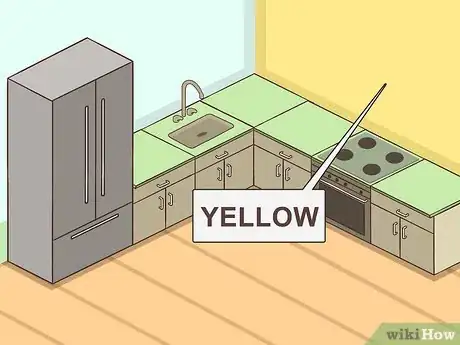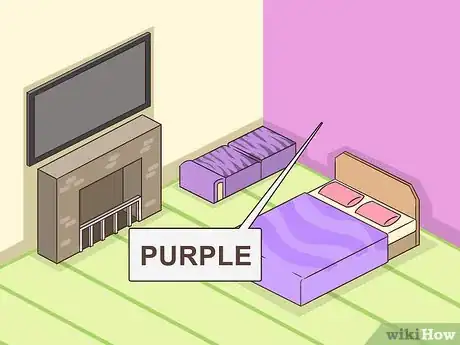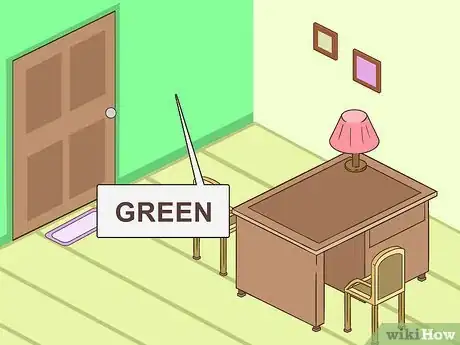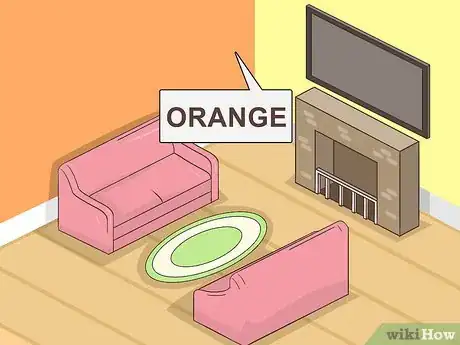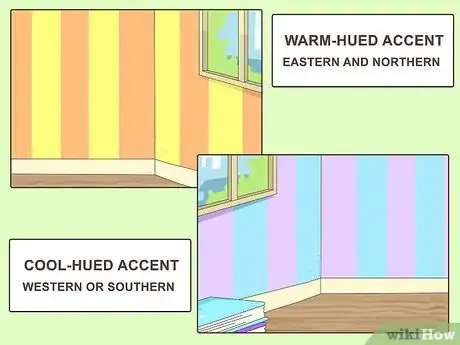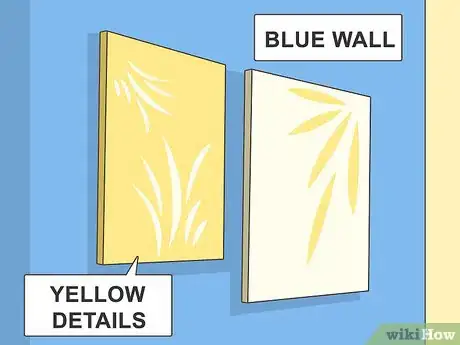This article was co-authored by Garrison Hullinger. Garrison Hullinger is an Interior Designer and the President of Garrison Hullinger Interior Design (GHID). With more than 15 years of experience, he specializes in client-centered design that balances beauty and warmth with comfort and functionality. Garrison and GHID’s work has been featured in numerous publications such as The New York Times, The Wall Street Journal, and Interior Design Magazine. Garrison attended Oklahoma Christian University.
There are 15 references cited in this article, which can be found at the bottom of the page.
This article has been viewed 37,423 times.
Do you ever want to change things up a bit in your home? Choosing to paint an accent wall in one of your rooms can take the decor and overall feel up a level. By brushing up on your knowledge of colors and assessing the room’s characteristics, you can succeed in picking the right accent for you.
Steps
Painting with Primary Colors
-
1Excite with red. Because it’s the most intense hue, red really raises a room’s energy level. Red is thought to speed up respiration and heart rate in addition to increasing blood pressure.[1]
- This may be a good color for a dining room or living room accent wall because it enhances appetite, draws people together, and stimulates conversation.
- Paint your entryway red to make a strong first impression.
- Avoid using shades of red in bedrooms, because the powerful color can excite too much to have in areas where people regularly sleep.[2]
-
2Encourage peace with blue. If you want a room to appear more bright and refreshing, light blue is the way to go.[3] [4] Darker blues are more sophisticated and can help anchor a room. Contrary to red shades, blue shades slow down heart rate and respiration, and also lower blood pressure.[5]
- Consider painting a blue accent wall in a bedroom or bathroom.
- There are tons of different shades of blue available and it’s a very versatile color that can be used with almost any style.
Advertisement -
3Uplift with yellow. This color, best used on a wall in a bathroom, kitchen, or dining room, communicates happiness and provides energy.[6] If you choose to paint all the walls in a room yellow, opt for a mellow or muted color as a harsh, saturated shade is hard on your eyesight and may even cause headaches.[7]
- A yellow accent wall in a crowded space can be especially helpful in providing the illusion of expansiveness and openness.
- Too much yellow can be a bad thing. In large amounts, yellow is thought to quicken tempers and make babies cry more.[8]
Painting with Secondary Colors
-
1Create versatility with purple. Purple combines the calm of blue and the energy of red. Because of this, different shades of purple have different purposes and effects.[9]
- Many use lilac or lavender in bedrooms to create an air of serenity.
- Deeper purples may be more suitable where creativity is encouraged or where you aim to express luxury.[10]
-
2
-
3Use orange for warmth. Orange inspires energy like red and joy like yellow. This is a great color for an accent wall because it makes a bold statement without being too overwhelming.[15] [16]
- Consider painting an orange accent wall in your exercise room because it may boost your energy a bit while also making you feel positive about your workout.
- You might want to use orange in an office or study because it helps increase creativity.
- Living rooms and dining rooms are also good places to have an orange accent wall.[17]
-
4Add some extra variety with unique patterns or materials. Don’t limit yourself to painting a solid color if you’re feeling more creative. You can either paint a unique pattern or you can have your accent wall be made of a different material entirely.[18]
- Create a modern design on a wall using painter’s tape or a stencil, then paint over it in a color that contrasts the existing wall color. Once the paint dries, remove the tape or stencil to reveal the wall color underneath.
- Use Venetian plaster to create a textured wall in eggplant purple to create some artistic pizzazz.
- If your style is more rustic, try a wood-paneled accent wall. You can do that by taking a pre engineered wood floor and just applying it to the wall.[19]
- Go for a stone accent wall to create a rich, sophisticated atmosphere in your home.
Creating Balance and Cohesion
-
1Choose colors that complement adjacent spaces. Keep in mind the colors used in nearby spaces throughout your home. If the space is open, you want the accent wall to complement the colors used in adjoining or adjacent rooms.
- For instance, if your dining room is open to your kitchen, the colors should work well together. You could use gray in one room and purple in another. A bright orange in one room and a muted green in another room wouldn’t be as cohesive.
-
2Contrast the natural light. Define the “visual temperature” of the natural light in the room. Choose warm-hued accent walls to create balance in eastern or northern rooms and cool-hued accent walls for western or southern rooms.
- If your room is located on the east or north side of your home, the quality of light entering the room during the day through the windows is cooler than the light coming from southern or western-facing windows.
-
3Paint an accent wall that will mesh well with the room’s architecture. An accent wall often looks the most dynamic and fitting when there are not any windows or doors to further busy the space.[20] [21] However, sometimes architectural features, such as a fireplace or nook, can be highlighted with an accent wall.[22]
-
4Choose a wall and color that best fill the room’s space. Different colors play tricks on perception in different ways. Warm colors tend to pull a wall toward the eye while cool colors tend to push a wall away from the eye. If a room feels too big or awkwardly long, you may want your accent color to be warmer, while a smaller room benefits from a cooler accent color.[23]
- Using a dark color in a small room creates a cozy, intimate feel, while a lighter color opens up the space and makes it feel larger.
-
5Complement your furniture. If you have the furniture in your room organized in a way that you want to keep, pick your accent wall and color in a way that further highlights one of your more eye-catching pieces in the room.[24]
- Pick a wall that an important piece of furniture sits in front of, such as a bed in a bedroom, or a large couch in a living room. This compliments an already attractive part of the room.
- Paint the wall a color that contrasts the furniture in front of it to highlight both the wall and the furniture. For instance, choose a light color for a wall that a dark-colored sofa sits against.
- Look at the tones in your throw pillows and wall art for inspiration.
-
6Incorporate your decor. While you have many color options for your accent wall, you should pick one that contrasts well with your decor. There’s a fine line between contrasting and clashing, so be careful with which combination you select. Some good examples are:[25]
- Yellow wall with blue or purple details
- Blue wall with yellow or blue details
- Red wall with white or blue details
- Orange wall with green details
- Purple wall with purple or yellow details
- Green wall with red, yellow, orange, purple, or blue details[26]
- You can also pair a neutral color with any other color to create a nice space.
-
7Remember the 60-30-10 rule. The most dominant color should make up 60% of a room, including the majority of paint and deco. A secondary color can account for 30% of a room, and 10% should be in an accent color. Try following this as closely as possible to achieve the best sense of balance.[27]
Community Q&A
-
QuestionDo accent walls make rooms look bigger?
 Juli RolandJuli Roland is a Color Specialist and the Founder of PaintColorHelp.com, one of the first companies in Dallas, Texas metro area that provides in-home color consultations and helps clients create paint color schemes. Juli has over 15 years of commercial and residential color consulting experience, including seven years as a custom-matcher in the paint industry. She earned her certification in color strategy from Camp Chroma and is a member of the Inter-Society Color Council. She has a BA in Advertising from Texas Tech University.
Juli RolandJuli Roland is a Color Specialist and the Founder of PaintColorHelp.com, one of the first companies in Dallas, Texas metro area that provides in-home color consultations and helps clients create paint color schemes. Juli has over 15 years of commercial and residential color consulting experience, including seven years as a custom-matcher in the paint industry. She earned her certification in color strategy from Camp Chroma and is a member of the Inter-Society Color Council. She has a BA in Advertising from Texas Tech University.
Certified Color Specialist An accent wall won’t really make a room look larger, but it can help a narrow wall in a rectangular room look a little wider, giving the space balance. If you have a long, skinny room, try using a darker, bolder color on the narrow end walls.
An accent wall won’t really make a room look larger, but it can help a narrow wall in a rectangular room look a little wider, giving the space balance. If you have a long, skinny room, try using a darker, bolder color on the narrow end walls. -
QuestionHow do I figure out if a paint color is right for me?
 Suzanne Lasky, ASIDSuzanne Lasky is an Interior Designer and the Founder of S Interior Design, a design consulting company based in Scottsdale, Arizona specializing in new home builds, home remodels, and all related design options for residential and small business clients. Suzanne has over 19 years of interior design and consulting experience. She is an Allied Member of the ASID (American Society of Interior Designers). She earned a Master of Business Administration (MBA) from Indiana University and an AAS in Interior Design from Scottsdale Community College.
Suzanne Lasky, ASIDSuzanne Lasky is an Interior Designer and the Founder of S Interior Design, a design consulting company based in Scottsdale, Arizona specializing in new home builds, home remodels, and all related design options for residential and small business clients. Suzanne has over 19 years of interior design and consulting experience. She is an Allied Member of the ASID (American Society of Interior Designers). She earned a Master of Business Administration (MBA) from Indiana University and an AAS in Interior Design from Scottsdale Community College.
Interior Design Consultant You really have to like the color. This is the one thing everyone overlooks when it comes to accent walls. You have to personally like the color of your wall. Forget about whatever you saw on Pinterest, and don't bother with the random advice you hear about "right" or "wrong" colors. If you like the way the color makes you feel and it suits the design of your space, then it's the right color for you.
You really have to like the color. This is the one thing everyone overlooks when it comes to accent walls. You have to personally like the color of your wall. Forget about whatever you saw on Pinterest, and don't bother with the random advice you hear about "right" or "wrong" colors. If you like the way the color makes you feel and it suits the design of your space, then it's the right color for you. -
QuestionWhat accent colors work well in a grey room?
 Suzanne Lasky, ASIDSuzanne Lasky is an Interior Designer and the Founder of S Interior Design, a design consulting company based in Scottsdale, Arizona specializing in new home builds, home remodels, and all related design options for residential and small business clients. Suzanne has over 19 years of interior design and consulting experience. She is an Allied Member of the ASID (American Society of Interior Designers). She earned a Master of Business Administration (MBA) from Indiana University and an AAS in Interior Design from Scottsdale Community College.
Suzanne Lasky, ASIDSuzanne Lasky is an Interior Designer and the Founder of S Interior Design, a design consulting company based in Scottsdale, Arizona specializing in new home builds, home remodels, and all related design options for residential and small business clients. Suzanne has over 19 years of interior design and consulting experience. She is an Allied Member of the ASID (American Society of Interior Designers). She earned a Master of Business Administration (MBA) from Indiana University and an AAS in Interior Design from Scottsdale Community College.
Interior Design Consultant It depends on your preferences, but even still, I don't have enough information about the space! We'd need to know what color the floor is! And what about the ceiling? Are there windows? You have to take all of this stuff into account in order to choose the "right" accent wall color. But above all else, you should like the color.
It depends on your preferences, but even still, I don't have enough information about the space! We'd need to know what color the floor is! And what about the ceiling? Are there windows? You have to take all of this stuff into account in order to choose the "right" accent wall color. But above all else, you should like the color.
Warnings
- There is a fine line between contrasting and clashing, so be careful with which combination of colors you select.⧼thumbs_response⧽
- Pick colors that work with your furniture, flooring, cabinets or countertops. Paint is cheap in comparison to replacing any of these.⧼thumbs_response⧽
References
- ↑ http://www.webmd.com/women/home-health-and-safety-9/color-psychology?page=2
- ↑ Juli Roland. Certified Color Specialist. Expert Interview. 27 March 2020.
- ↑ Juli Roland. Certified Color Specialist. Expert Interview. 27 March 2020.
- ↑ https://www.lowes.com/projects/paint-stain-and-wallpaper/choose-paint-colors-and-schemes/project
- ↑ http://freshome.com/room-color-and-how-it-affects-your-mood/
- ↑ Juli Roland. Certified Color Specialist. Expert Interview. 27 March 2020.
- ↑ https://www.colormatters.com/color-and-vision/color-and-vision-matters
- ↑ http://freshome.com/room-color-and-how-it-affects-your-mood/
- ↑ https://www.lowes.com/projects/paint-stain-and-wallpaper/choose-paint-colors-and-schemes/project
- ↑ http://freshome.com/room-color-and-how-it-affects-your-mood/
- ↑ Juli Roland. Certified Color Specialist. Expert Interview. 27 March 2020.
- ↑ http://www.foxnews.com/lifestyle/slideshow/2013/10/11/feeling-moody-10-room-colors-that-might-influence-your-emotions.html#/slide/green
- ↑ http://www.webmd.com/women/home-health-and-safety-9/color-psychology?page=2
- ↑ Juli Roland. Certified Color Specialist. Expert Interview. 27 March 2020.
- ↑ Juli Roland. Certified Color Specialist. Expert Interview. 27 March 2020.
- ↑ https://www.lowes.com/projects/paint-stain-and-wallpaper/choose-paint-colors-and-schemes/project
- ↑ http://www.elledecor.com/design-decorate/color/news/a8472/how-color-affects-your-mood/
- ↑ http://www.homedit.com/accent-wall-ideas/
- ↑ Garrison Hullinger. Interior Designer. Expert Interview. 2 November 2022.
- ↑ Juli Roland. Certified Color Specialist. Expert Interview. 27 March 2020.
- ↑ http://www.housepaintingtutorials.com/painting-accent-walls.html
- ↑ https://www.wagnerspraytech.com/press-room/how-to-choose-an-accent-wall-color/
- ↑ http://retrorenovation.com/2012/06/12/accent-walls-4-steps-to-getting-them-right/
- ↑ http://www.realtor.com/advice/home-improvement/accent-walls/
- ↑ https://www.houzz.com/ideabooks/44898504/list/how-to-pick-the-perfect-accent-color
- ↑ https://www.wagnerspraytech.com/press-room/how-to-choose-an-accent-wall-color/
- ↑ http://www.hgtv.com/design/decorating/color/top-10-tips-for-adding-color-to-your-space


